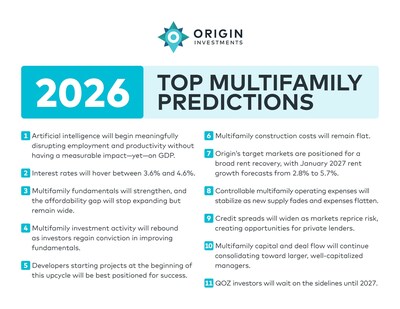Mix of Kaleidoscopic Uncertainty and Cautious Optimism Shape 2026 Multifamily Investment Landscape
Origin Investments Co-CEO Says AI Could Cause Significant Disruption Without Immediate GDP Impact in 2026 and Beyond
CHICAGO, Nov. 20, 2025 /PRNewswire/ -- Tariff and trade policy shifts, the longest government shutdown in U.S. history and the potential long-term implications of increasing artificial intelligence adoption are causing kaleidoscopic unpredictability in commercial real estate.
"Patient investors and managers will be rewarded by early entry into 2026 development opportunities."According to leading real estate fund manager Origin Investments it means that in 2026 commercial real estate investors should keep planning horizons short and long-term outlooks flexible. Origin Investments Co-CEO David Scherer Top Predictions for Multifamily Investing in 2026 echo his confidence in sector fundamentals from 2025. And he expects patient investors and managers to be rewarded by early entry into 2026 vintage development opportunities, even with the year's political unknowns.
"Businesses have been operating in a period of unpredictability that has kept them on reactionary footing. Yet the economy has proven sturdy," Scherer said. "But numerous outside factors in 2026, including the mid-term elections, could reshape that dynamic or intensify it."
Scherer's 2026 predictions include:
1. AI will disrupt employment and productivity without impacting GDP—yet.
AI's infrastructure phase is pumping billions of dollars into building data centers, computing power and the electrical grid to support it. And it is fueling growth similar to the internet's late-1990s period. However, the impact on GDP remains unclear. Accelerating in 2026, AI won't just amplify human work; increasingly, it will substitute for it.
"My base case for 2026 is slightly slower GDP expansion than the roughly 3.8% pace seen recently," Scherer said. "But I don't expect a recession—even with deflationary effects on wages and disruption to mostly white-collar jobs. As businesses incorporate AI, the impact on bottom lines and potential for job creation is unclear."
2. Interest rates will hover between 3.6% and 4.6%.
Origin expects interest rates in the 3.6%-4.6% range. No drastic cuts or hikes are expected because the U.S. is facing extraordinary debt supply: about $38 trillion in total federal debt and approximately $1.8 trillion in annual deficits. With the need to sell up to $15 trillion in bonds each year, it will be difficult for rates to fall measurably.
"There are unknowns, but the Federal Reserve has acted responsibly, and the economy is resilient," Scherer said. "Even with front-end rates remaining higher than two-year yields, the current yield curve signals a balanced long-term outlook."
3. Multifamily fundamentals will strengthen; the affordability gap will stop expanding.
Scherer suggests a rebalancing will occur in 2026. As the recent supply wave is absorbed, concessions will decline and rent growth will improve. The affordability gap between renting and homeownership will plateau and could narrow slightly in 2026. But even so, homeownership is far more expensive, and affordability remains a tailwind for the sector.
4. Multifamily investment activity will rebound.
Scherer expects a turning point in 2026: Deal volume will accelerate as prices adjust and once-cautious investors develop a taste for risk and potential rewards. But underwriting remains tight, and managers must remain disciplined.
"Multifamily real estate has gone through a sort of recession in recent years," Scherer said. "As we emerge, I believe the 2026 vintage will reward well-capitalized, organized managers and investors who move early in the next upcycle rather than waiting for the crowd."
5. Developers starting projects now will be best positioned for success.
It's still a challenge to get new projects started and it will remain that way in 2026. But the moment offers opportunity for developers with vision and deals that pencil. Supply is declining, new starts are down 70% from peak, demand is robust and rent growth is projected to accelerate. The 2026 development landscape will be defined by scarcity and selectivity. Developers who start now stand to deliver into what Scherer sees as one of the most favorable rent-growth windows of the decade.
6. Multifamily construction costs will remain flat.
Myriad factors guide Origin's prediction for flat construction pricing in 2026. Most notably, diminished pipelines give leverage to developers to keep costs down. As long as tariffs are an option for the administration, they will be a wild card. However, given overall conditions, they haven't yet materially impacted pricing levels.
7. Origin's target markets are positioned for a broad rent recovery.
Historically, annual multifamily rent growth has averaged approximately 3% nationally. Origin predicts a steady recovery as the supply of units declines, absorption improves and rent growth reaccelerates. According to Multilytics®, Origin's proprietary AI model that forecasts year-over-year multifamily rent growth, nine of Origin's 15 target markets are expected to have rent growth greater than 4.4% (Charlotte leads at 5.7%, followed by Houston, Las Vegas, Jacksonville, Raleigh, Dallas, Colorado Springs, San Antonio, and Atlanta.). Five markets will have growth between 3.56% and 3.95%. Only one market will is projected to fall below the 3.0 percent level (Austin at 2.8%).
8. Controllable multifamily expenses will stabilize.
In the wake of the steady stream of new deliveries and with short-term rent growth elusive, operators will carefully scrutinize each line item. They will benefit from moderating payroll and materials costs, the flattening of insurance costs (increases of 0-2%), scaling vendor pricing and maximizing tech-enabled efficiencies.
9. Credit spreads will widen moderately.
Credit spreads, which remain near the tightest levels seen in decades, are expected to widen moderately in 2026, accelerating in the second half. The beginning of the institutional demand shift towards equity investments and lower benchmark rates will prompt lenders to seek higher yield premiums, creating a more favorable environment for disciplined private credit managers.
The wild cards that could influence the 2026 credit landscape: a continuation of "extend and pretend" behavior, trapping recapitalization opportunities on balance sheets, and unexpectedly high investor demand.
"Demand for private credit is likely at or nearing its peak," Scherer said. "But credit dislocation equals opportunity with better entry points, higher yields and stronger covenants that help reduce risk."
10. Multifamily capital will continue consolidating.
The multifamily sector will continue consolidating in 2026 as firms struggle to raise equity or secure financing in today's constricted capital environment. This consolidation will directly shape 2026 deal activity. As fundamentals strengthen, the best-positioned firms will be those that retained talent, preserved lender relationships, and protected their operating engines through the slowdown. Disciplined managers that can source, finance and operate through cycles will be winners.
11. QOZ investors will wait on the sidelines until 2027.
Scherer predicts QOZ investors will delay commitments, perhaps at their own peril. The step-up benefit in January 2027, tied to the five-year deferral period, may seem too good to pass up. However, future QOZ maps will introduce stricter eligibility criteria, including a 70% area median income threshold, that could shift designations into markets where deals no longer pencil without subsidies such as tax-increment financing districts. Investors focusing on the viability of a deal, not solely the tax treatment of gains, may have an advantage.
Read Scherer's article on his predictions here.
Watch the webinar where he delivered his predictions here.
One year ago, in 2025, Scherer made these predictions.
About Origin Investments
Founded in 2007, Origin Investments is a private real estate manager that helps high-net-worth investors, family offices and registered investment advisors grow and preserve wealth by providing tax-efficient real estate solutions through private funds. We build, buy and finance multifamily real estate projects in fast-growing markets throughout the U.S. In 2023, we founded affiliate firm Origin Credit Advisers, an SEC-registered investment adviser that provides yield-focused multifamily debt investments for qualified purchasers. SEC registration does not constitute an endorsement by the Commission nor does it indicate that the adviser has attained a particular level of skill or ability. Through our Origin Exchange platform, introduced in 2024, investors can complete a 1031 exchange of their properties for professionally managed, institutional-quality assets. To learn more, visit www.origininvestments.com.
![]() View original content to download multimedia:https://www.prnewswire.com/news-releases/mix-of-kaleidoscopic-uncertainty-and-cautious-optimism-shape-2026-multifamily-investment-landscape-302622331.html
View original content to download multimedia:https://www.prnewswire.com/news-releases/mix-of-kaleidoscopic-uncertainty-and-cautious-optimism-shape-2026-multifamily-investment-landscape-302622331.html
SOURCE Origin Investments



